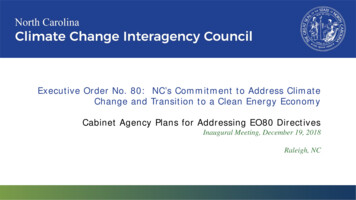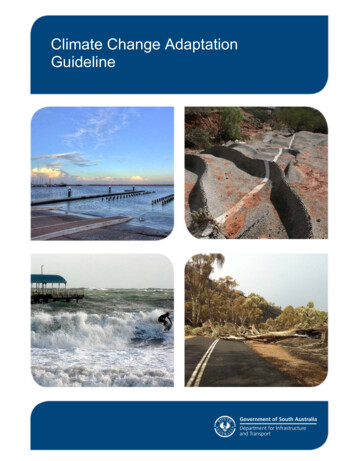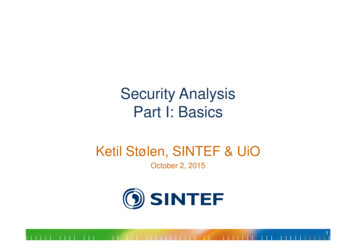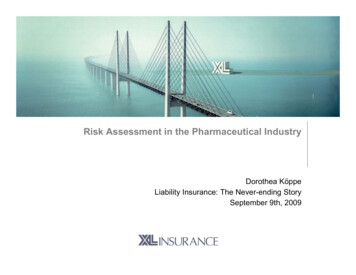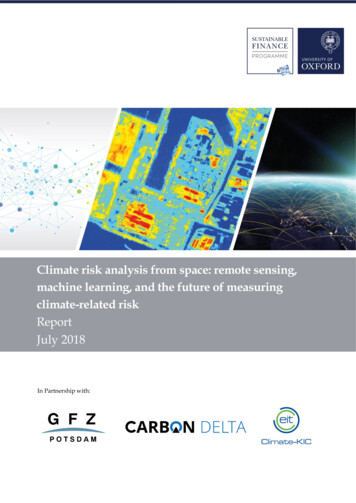
Transcription
Climate risk analysis from space: remote sensing,machine learning, and the future of measuringclimate-related riskReportJuly 2018In Partnership with:
AboutAbout the ConsortiumOxford Sustainable Finance ProgrammeThe Oxford Sustainable Finance Programme at the University of Oxford Smith School of Enterprise andthe Environment is a multidisciplinary research centre working to be the world's best place for researchand teaching on sustainable finance and investment. The Programme was established in 2012 tounderstand the requirements, challenges, and opportunities associated with a reallocation of capitaltowards investments aligned with global environmental sustainability.The Programme is based in a world leading university with a global reach and reputation. We work withleading practitioners from across the investment chain (including actuaries, asset owners, asset managers,accountants, banks, data providers, investment consultants, lawyers, ratings agencies, stock exchanges),with firms and their management, and with experts from a wide range of related subject areas (includingfinance, economics, management, geography, anthropology, climate science, law, area studies,psychology) within the University of Oxford and beyond.Carbon DeltaCarbon Delta has performed a considerable amount of research on the availability of climate risk data andthe expertise needed to maximise the outcomes of such a project. Carbon Delta is a climate research firmthat specialises in identifying and analysing the climate change resilience of publicly traded companies.Furthermore, Carbon Delta has developed a database of company locations for 25,000 enterprises.Carbon Delta provides coordinates for millions of production installations, processes satellite imagery andintegrates data and runs assessment methodologies. When processing the satellite imagery, Carbon Deltawill develop a 3-dimensional understanding of the technological activity happening at facilities forpotentially thousands of companies.German Research Centre for Geosciences (GFZ)The Helmholtz-Zentrum Potsdam - German Research Centre for Geosciences (GFZ) is the GermanNational Research Centre for Earth sciences and a member of the German Helmholtz Association (HGF).One of the GFZ methodical core competences are in application and development of satellite technologiesand spacebased measuring methods to monitor Earth surface variables and processes from a range ofspatial and temporal scales using in-situ, airborne and space-borne instruments. The GFZ Remote Sensingsection focuses on the development and use of remote sensing techniques for the monitoring of landsurfaces. In particular, research lines comprise (i) methodological developments for remote sensing dataanalysis and definition of future satellite missions, and (ii) application-oriented research for themonitoring of bio- and geophysical parameters of interest to a wide range of scientific disciplines,including land degradation studies, natural resources, global vegetation functioning, and landatmosphere interactions. In particular, the remote sensing section is renowned for its expertise inhyperspectral remote sensing and is the scientific leader of the EnMAP hyperspectral satellite sensor to belaunched in 2019.Project funded via EIT Climate-KIC’s CSA BoosterThis innovative project has been made possible through seed-funding from EIT Climate-KIC via CSABooster (http://csabooster.climate-kic.org), a flagship programme of its Sustainable Land Use theme. EITClimate-KIC is a European knowledge and innovation community, working to accelerate the transition toa zero-carbon economy. Supported by the European Institute of Innovation and Technology, it identifiesand supports innovation that helps society mitigate and adapt to climate change.Integrating Remote Sensing Data into Climate Risk Analysis2
Climate-KIC’s CSA Booster is Europe’s leading innovation hub, community and collaboration platformpioneering the transition to climate-smart agriculture across Europe, and around the world. Established in2015, CSA Booster brings together a multi-stakeholder ecosystem of public and private sector partnersincluding some of the leading research institutions in Europe, corporates, start-ups and internationalorganizations to catalyse, incubate and scale innovative CSA solutions and to de-risk investments intoCSA. CSA Booster has partners and projects in all major EU regions and currently acts as the Europeanregional hub for the Global Alliance for Climate-smart Agriculture (GACSA) initiative, hosted by theUN’s Food and Agriculture Organisation (FAO).Integrating Remote Sensing Data into Climate Risk Analysis3
About the AuthorsOxford Sustainable Finance ProgrammeDr Ben Caldecott is the founding Director of the Oxford Sustainable Finance Programme at the Universityof Oxford Smith School of Enterprise and the Environment. He is concurrently an Academic Visitor at theBank of England, a Visiting Scholar at Stanford University, a Senior Advisor at Highmore LLC, and aSenior Associate Fellow at Bright Blue. Ben specialises in environment, energy, and sustainability issuesand works at the intersection between finance, government, civil society, and academe, having held seniorroles in each domain.Lucas Kruitwagen is the Data Lead at the Oxford Sustainable Finance Programme and a D.Phil. Studentin the University of Oxford School of Geography and the Environment. Lucas researches how data-driventechnology is changing the availability of environmental risk information, particularly in relation tocompany and investor risk exposure. Lucas is also a Visiting Researcher at Imperial College Londonwhere he researches organisational decision-making under conditions of risk and uncertainty. He holdsan MSc (with distinction) in Sustainable Energy Futures from Imperial College London where he was aClimateKIC Master's Label Student, and a BEng from McGill University, Montreal, where he was a LoranScholar.Dr Matthew McCarten is a Postdoctoral Research Associate at the Oxford Sustainable FinanceProgramme. Prior to joining Oxford he completed his PhD thesis in finance at the University of Otago,New Zealand in 2017. His thesis examined the determinants and consequences of securities class actions.In particular, investigating the association between securities class actions and various corporatecharacteristics, including debt financing, political lobbying and innovation. He also holds a MBus (withdistinction) and a BCom from the University of Otago.Dr Xiaoyan Zhou is a Postdoctoral Research Associate at the Oxford Sustainable Finance Programme. Herresearch interests focus on Responsible Investment, Carbon Disclosure/Emission and InstitutionalShareholder Engagement. Prior to joining the Sustainable Finance Progamme, Xiaoyan Zhou was incharge of establishing two joint venture companies in China and fully participated two IPOs onAustralian Stock Exchange and London Stock Exchange Alternative Investment Market during 2003-2007.She holds a PhD in Finance from ICMA Centre, Henley Business School and MLitt in Finance andManagement from University of St Andrews.Carbon DeltaDavid Lunsford is a Co-Founder and Head of Development for Carbon Delta, where he designs riskassessment methodologies, manages a team of research analysts, oversees and validates analytical results,and builds client relationships for the firm. He previously worked for several years on climate changemitigation and greenhouse gas trading issues in Europe and China, supporting large companies inmanaging climate risks associated with the transition to a low carbon economy. David possesses 11 yearsof experience bringing diverse stakeholders together on varying levels, encouraging new climate changestrategies that make sense for business, investors and policymakers alike.Oliver Marchand is a Co-Founder and CEO of Carbon Delta. Prior to this, he spent 9 years with FischAsset Management as Head of IT. In that position he led a team that was responsible for all IT operationsand development of the in-house portfolio management system. Moreover, Oliver worked as a researcherin weather forecasting for almost a decade at various weather services. This included exciting researchprojects such as the development of thunderstorm warning systems and wind profiling data integration,and required a high-performance computing cluster operation. Oliver holds a Ph.D. in Computer Sciencefrom ETH Zürich. He is passionate about programming, triathlon, solar cooking and his family.Phanos Hadjikyriakou is a Data Analyst at Carbon Delta. He is working on methods to approximatesupply chain information, using multi-regional input-output analysis. Part of his research includes waterIntegrating Remote Sensing Data into Climate Risk Analysis4
accounting, natural capital valuation and scope 3 carbon footprints. Phanos is passionate about usingmacro-economic data to increase the transparency of global supply chains and quantify theirenvironmental impacts. He studied at the ETH Lausanne and Zurich and will soon graduate with aMasters in Environmental Engineering.Valentin Bickel is a PhD student at the Swiss Federal Institute of Technology Zurich (Switzerland) andthe Max Planck Institute for Solar System Research in Göttingen (Germany), working in the field ofRemote Sensing and Planetary Science. He joined the Carbon Delta team as an external consultant.German Research Centre for Geosciences (GFZ)Prof. Dr. Torsten Sachs is the head of the Earth-Atmosphere Interactions Group within the GFZ SectionRemote Sensing. His research focusses on the land-atmosphere exchange of heat, water vapor, andgreenhouse gases (CO2, CH4) from local (m² - ha) to regional ( 10.000 km²) scales using stationary andmobile (airborne) platforms in both temperate and high latitudes. He has 14 years of research experienceincluding eight extensive aircraft and helicopter-based campaigns in the US, Canadian, and SiberianArctic as well as northern Scandinavia. Among other projects, he is involved in the EU Horizon2020Research and Innovation Actions INTAROS and NUNATARYUK, as well as in the Cofund ERA-NETsERA-GAS and ERA-PLANET. He serves in the Science Advisory Group of the German-French MethaneRemote Sensing LIDAR (MERLIN) Mission to be launched in June 2020.Niklas Bohn is a PhD candidate at GFZ Postdam undertaking work in the remote sensing section. Niklashas also worked as a research assistant and interned at GFZ between 2016 and 2017. He has also internedat the United Nations Platform for Space-based Information for Disaster Management and EmergencyResponse (UN-SPIDER). He holds a Master of Science in Studies of Environmental Geography andManagement.DisclaimerThe Chancellor, Masters, and Scholars of the University of Oxford, Carbon Delta, and GFZ GermanResearch Centre for Geosciences make no representations and provide no warranties in relation to anyaspect of this publication, including regarding the advisability of investing in any particular company orinvestment fund or other vehicle. While we have obtained information believed to be reliable, neither theUniversity, Carbon Delta, and GFZ German Research Centre for Geosciences, nor any of its employees,students, or appointees, shall be liable for any claims or losses of any nature in connection withinformation contained in this document, including but not limited to, lost profits or punitive orconsequential damages.Integrating Remote Sensing Data into Climate Risk Analysis5
ContentsAbout . 2About the Consortium . 2About the Authors . 4Disclaimer . 5Executive Summary . 71. Introduction . 81.1.Questions . 92. Identifying Technology Features at Assets . 102.1.Data Availability . 102.2.Algorithms. 113. Measuring GHG Emissions . 133.1.Direct Emissions Monitoring . 133.1.1.Available Instruments . 133.1.2.Retrieval Methods. 173.1.3.Detection Thresholds and Retrieval Precision . 183.1.4.Conclusion . 193.2.Indirect Emissions Monitoring . 204. Asset Environment and Localisation . 214.1.Automatic Asset Environment Classification . 214.2.Utilisation of OpenStreetMap for Asset Identification and Localisation . 245. Sectoral Details . 265.1.Agriculture . 265.2.Heavy Industry . 285.2.1.Aluminium Electrolysis & Exclusion . 285.2.2.Cement . 295.2.3.Chemicals & Industrial Processes . 305.2.4.Oil Refining & Upgrading . 315.2.5.Pulp & Paper . 315.2.6.Glass . 325.2.7.Iron & Steel . 335.3.Mining . 345.3.1.Bauxite . 345.3.2.Coal . 355.3.3.Gold . 375.3.4.Uranium . 375.3.5.Iron Ore . 375.3.6.Diamond . 385.4.Oil & Gas Extraction. 395.5.Power Sector . 425.5.1.Coal . 425.5.2.Gas . 425.5.3.Oil. 425.5.4.Nuclear . 425.5.5.Solar PV . 435.5.6.Wind . 455.6.Retail & Commercial . 465.7.Overview . 466. Conclusion . 47Glossary . 48Appendix A: Spaceborne Instruments for Monitoring Atmospheric GHG Concentrations . 49Appendix B: Sectoral Summary Table . 50Integrating Remote Sensing Data into Climate Risk Analysis6
Executive Summary Accurate asset-level data can dramatically enhance the ability of investors, regulators,governments, and civil society to measure and manage different forms of environmental risk,opportunity, and impact. Asset-level data is information about physical and non-physical assetstied to company ownership information.Remote sensing (and related technological developments such as machine learning) can helpsecure better asset-level data and at higher refresh rates. In particular remote sensing can helpidentify the features and use of assets relevant to determining asset-level GHG emissions.We expect that the development of a global catalogue of every physical asset in the world to bealready within the reach of technical feasibility. The process of identifying and tagging assets(e.g. power generating stations, mines, farms, industrial sites) and asset-level features (e.g. coolingtechnologies, air pollution control technologies) can be automated through the use of machinelearning.It is possible to train learning algorithms to recognise an asset and its features in remoteimagery and then scan global imagery corpuses to identify all assets of that type. Human errorrates are sufficiently low on these classification tasks that it is reasonable to expect these problemsto be entirely automatable.With the exponential increase in space-based sensing, computing power, and algorithmiccomplexity, end-to-end learning systems are becoming increasingly available to academicresearchers and the private sector alike.There are also viable methods using remote sensing data that could be implemented tomeasure asset-level GHG emissions. These methods are: (1) a direct method, which involves theuse of various sensors on spaceborne and airborne instruments to measure emissions directly; and(2) an indirect method, which utilises various identifiable asset characteristics to model GHGemissions.The direct method of monitoring emissions requires the use of satellite or airborne instruments.Accurately monitor GHGs from space is challenging because of their relatively small signal incomparison to other atmospheric constituents, but advances in both sensor technology andretrieval models are leading to more precise detection.Direct emission monitoring is currently feasible for a relatively limited scope of assets (such asassets that are situated in regions with very few other sources of emissions in the surroundingarea). The launch of the CarbonSat satellite in 2020 as well as some already scheduled sunsynchronous sensors offer the potential for more precise observation of GHG concentrationsand emissions at the asset-level.A complementary approach to direct measurement is to model GHG emissions indirectly usingidentifiable asset characteristics. This requires the identification of key characteristics that areassociated with GHG emissions. For example, asset utilisation rates are inherently linked to thelevel of GHG emissions. Using some of the spaceborne instruments in combination with realasset-level production data it is possible to model an asset’s utilisation rate. Employing thisprojection of the utilisation rate an estimate of the emissions can then be obtained using astandardised model. The indirect approach represents a more feasible method of measuringGHG emissions based on currently available technology.Through future research projects undertaken over multiple phases we plan to make asset-leveldata (including various technical features) and GHG emissions monitoring for each asset(using both direct and indirect methods) available for every physical asset in every sectorglobally, beginning with the most GHG intensive assets. We hope to create platforms forvarious users to access and use this data. This endeavour has the potential to transform howdifferent actors in different parts of society measure and manage environmental risks, impactsand opportunities. It is enabled by significant public (and private) investment in data capture andremote sensing, which can now be brought together and processed in novel ways for directapplication.Integrating Remote Sensing Data into Climate Risk Analysis7
1. IntroductionAccurate asset-level data can dramatically enhance the ability of investors, regulators, governments, andcivil society to measure and manage different forms of environmental risk, opportunity, and impact.Asset-level data is information about physical and non-physical assets tied to company ownershipinformation. Asset-level data can be aggregated at the company, regional, or global level suiting a varietyof needs, for example: Asset managers want data that can be analysed so as to differentiate between companies. Theywould like to be able to do that across asset classes (e.g. equities, non-listed, corporate bonds etc.),sectors (e.g. downstream energy, upstream energy, transport, property etc.), and markets (e.g. US,China, EU etc.). Companies own portfolios of assets and so understanding the exposure ofcompany assets to environmental factors and aggregating this data to the parent company-level isthe best way of understanding firm wide exposure. In turn, asset owners want to be able to know the exposure of their asset managers so they candifferentiate between them and compare them to benchmarks. If we know who owns whichcompanies, and we know how exposed each company asset is to different risks, then we caneffectively analyse asset manager exposure. Citizen savers are increasingly concerned about ethical considerations and trends such as thefossil fuel divestment campaign. They want to know which asset owners and which fund optionsare most aligned with their concerns and priorities. This trend is accelerating due to the trendtowards ‘Defined Contribution’ pension schemes opposed to more traditional ‘Defined Benefit’ones. Regulators, as recently demonstrated by interventions from the Governor of the Bank of Englandand others, are interested in where risk is in the system and whether it could have financialstability implications if there is a disorderly correction due to rapid changes in asset prices. Theywant to see which entities own assets most at risk – for example, which systemically importantfinancial institutions are exposed directly or indirectly to particularly at risk assets. Finally, policymakers and civil society want to know whether we are on track to delivering thetransition to a low carbon economy, whether in aggregate (e.g. globally, regionally, nationally) orin terms of specific companies or sectors within countries. To do this, they need to know howmuch ‘committed emissions’ there are from existing assets or will be from planned capitalexpenditure. Civil society will want to examine whether companies’ rhetoric and action add up,and also whether financial institutions own or are financing companies and assets that areincompatible with climate change and other environmental challenges.Asset-level data resides in a wide range of different locations. It exists in current company disclosures tofinancial markets, regulators, and government agencies (in multiple jurisdictions and in differentlanguages); in voluntary disclosures; in current proprietary and non-proprietary databases; in public andprivate research institutions; and in academic research. Despite this, it is often of very poor quality, interms of both coverage and accuracy. As a result, the use of remote sensing to identify asset-level data cansignificantly improve our understanding of asset-level risks.This report examines the potential role of remote sensing (and related technological developments such asmachine learning) to secure better asset-level data and at higher refresh rates. In particular we focus onusing remote sensing to identify the features and use of assets relevant to determining their greenhousegas (GHG) emissions. Remote sensing combined with machine learning could potentially provide theability to: Conduct ‘persistent’ monitoring of assets; Significantly enhance the determination of asset ownership; Facilitate satellite measurement of asset-level greenhouse gas (GHG) emissions; Allow the ‘real time’ monitoring and identification of local environmental impacts;Integrating Remote Sensing Data into Climate Risk Analysis8
Make data and analysis available to a wide range of stakeholders helping to ensure that the moresophisticated approaches benefit to society as a whole; and Combine remote sensing environmental risk analysis with large scale financial databases todevelop innovative products.1.1. QuestionsAs part of our research we focused on the following questions: What is the accessibility of high resolution satellite data offered via non-commercial satellites tomeasure GHG emissions from large emitting assets? What data products are offered by other, possibly commercial, data providers to measure GHG? What is the accessibility of high resolution remote sensing data to identify technology features ofassets? What is the feasibility of developing a methodology for asset-level GHG measurement throughremote sensing? What is the feasibility of developing a methodology for identifying technology features of assets?The report is organised as follows. Section 2 provides an overview of the data sources that are availableand the methods that can be implemented for the identification of asset-level technology features. Section3 outlines two potential methods for measuring GHG emissions. These methods are: (1) a direct method,which involves the use of various sensors on spaceborne and airborne instruments to measure emissionsdirectly; and (2) an indirect method, which utilises various identifiable asset characteristics to model GHGemissions. Section 4 outlines a method to automatically identify an assets environment and presents anapproach for using OpenStreetMaps to identify the location of assets. In Section 5 a pilot study analysingthe feasibility of identifying types of assets and their features from space is reported. Finally, Section 6provides concluding remarks.Integrating Remote Sensing Data into Climate Risk Analysis9
2. Identifying Technology Features at AssetsMany human-made assets have features that indicate their actual or potential impact on the naturalenvironment, as well as the exposure of an asset to different environment-related risks (andopportunities).For example, assets in locations with high population density, serious local
ERA-GAS and ERA-PLANET. He serves in the Science Advisory Group of the German-French Methane Remote Sensing LIDAR (MERLIN) Mission to be launched in June 2020. Niklas Bohn is a PhD candidate at GFZ Postdam undertaking work in the remote sensing section. Niklas has also worked as a research assistant and interned at GFZ between 2016 and 2017.


